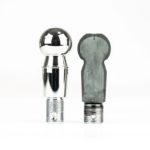The quest to make materials harder, stronger and lighter is one with constantly shifting goals, but for vehicle original equipment manufacturers (OEMs), it’s one with real design and performance advantages. Here, Kostas Poulios, principal design & development engineer at steering system specialist Pailton Engineering, explains the importance of induction hardening for fundamental vehicle components.
Ball joints are an integral part of a vehicle’s suspension, keeping the wheels properly aligned as they contend with road surface irregularities. But, for vehicles that must withstand harsh under chassis environments, how do you ensure that these components are fit for purpose?
Unfortunately, it is not as simple as just manufacturing commercial vehicle ball joints in their thousands. Each one needs to be precision made to exact measurements and then rigorously tested to ensure that they are ‘up to the job’. The chosen manufacturing processes have real consequences on the hardness and surface finish of the final component.
Firstly, bar fed machines produce the full net shape of the ball pin from a solid bar. Each ball pin is checked against the tolerances specified in the drawings and the profile of the pin is checked. This will ensure the component has the best geometry, prior to the induction hardening process.
The ball pins then go on to the induction hardening process where the ball pin, neck and taper are hardened to the required depth and hardness ranges. Again, the components need to be checked against the drawings, which specify where the hardened zones must be. Only then will the component move on to the assembly area. Some companies only harden the sphere, so you want to look for a vehicle parts manufacturer that hardens the sphere, the neck and the taper.
By having a controlled form on the hardening feature, manufacturers can achieve a massive increase in fatigue life. This will eliminate any excessive wear when the ball pins are rotating. Crucially, when you extend the hardening zone through to the neck and the taper, you get an even bigger increase in fatigue life. This has obvious design advantages such as decreased maintenance costs over the service life of the component.
It’s also advantageous to induction harden the spherical area of the sockets. This is the contact area between the sphere of the ball pin and the spherical area of the socket. This will further extend the life of the component from a wear point of view, and will ensure smooth use and rotation.
At Pailton Engineering, all the machines for hardening are designed and manufactured bespoke for the factory. This equips the company with all the variants in tools and forms so that they can harden all net shaped ball pins. While the search for innovative new materials continues, Pailton Engineering’s ball pin manufacturing approach ensures the correct balance of material, which provides the right blend of machineability, hardenability and cost.









